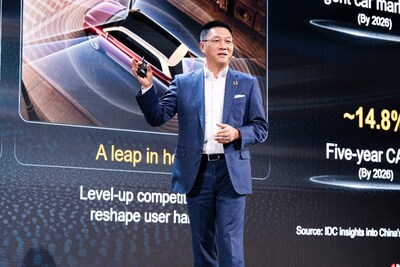Published on: Tuesday, 14 October 2025 ● 4 Min Read
PARIS, Oct. 14, 2025 -- At the 11th Ultra-Broadband Forum (UBBF) 2025, James Chen, the President of Huawei's Carrier Business, shared a number of new best practices the company has developed with operators that drive growth with AI-powered ultra-broadband (UBB). In his keynote speech, "Triple Leaps to AI UBB: Inspiring New Business Growth," Chen said operators have taken leaps in depth, breadth, and height to create new growth in the AI UBB era.

"Leapfrog innovations drive great business success," he said. "Operators can seize this major opportunity to create new growth by deepening experience assurance capabilities, expanding business boundaries to include digital and intelligent services, and competing at higher levels by accelerating network intelligence." Based on operators' practices in different sectors, Chen interpreted the leaps in three dimensions of innovation: depth, breadth, and height.
A leap in depth: Driving a paradigm shift from bandwidth- to experience-centric monetization
Carriers combine AI capabilities with networks to accurately detect where application experience improvements are needed and proactively ensure the experience of key applications such as AI cloud gaming and 4K livestreaming, achieving a leap from user-level to application-level experience monetization.
An example of how this new monetization model helps operators is a leading operator from Thailand that has used Huawei's AI WAN solution to develop new application-level experience assurance capabilities. This has enabled users to enjoy a smoother gaming experience, while the operator has drastically increased average revenue per user (ARPU).
A leap in breadth: Pushing the business boundaries to include digital intelligence and computing services
A leap in height: Network O&M transformation from work-order-driven operations to intelligent operations
Operators can drive level 4 network autonomy for more intelligent networks to move away from work-order-driven operations towards intelligent operations.
For example, Huawei has worked with MasOrange in Spain to build Europe's first level 4 autonomous IP network. Using iMaster NCE, the operator has been able to reduce mean time to repair (MTTR), which in turn helps to enhance user satisfaction.
Chen wrapped up his speech by saying that AI UBB is just starting out, and that Huawei is excited to work with operators and industry partners to pursue continuous innovation. The company aims to help operators succeed in the AI era through experience monetization, a second growth curve, and OPEX reduction.
![]() View original content:https://www.prnewswire.co.uk/news-releases/huawei-james-chen-taking-triple-leaps-to-ai-ubb-and-inspiring-new-business-growth-302583510.html
View original content:https://www.prnewswire.co.uk/news-releases/huawei-james-chen-taking-triple-leaps-to-ai-ubb-and-inspiring-new-business-growth-302583510.html

No comments posted
© 2019 KIVAA Group | All right reserved. www.theindustrial.in
Leave a reply: